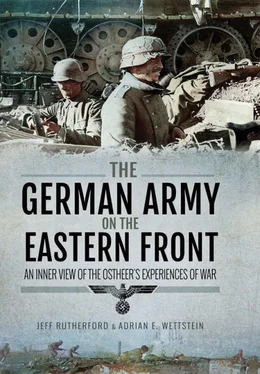Independently of each other, both battalion leaders made the decision to take advantage of the momentary success and to push through to the harbour. Assault guns ahead, closely followed by the infantry, they push through from street to street. Second Battalion intercepts heavy counterattacks from the railway area at the west edge again and again, thereby shielding the right flank of the First Battalion, for which it become possible through this to reach the harbour in a bold thrust at 6.00pm. Through this bold penetration, all [enemy] elements west of the Tsemes were cut off and the defensive front around Novorossiysk collapsed. Now, however, success must be maintained. The battalions take up an all-around defensive position. Counterattacks, especially from the west, are always repelled, 4 guns are stormed. 1 anti-tank company and the Bicycle Company 173 are immediately thrown forward as reinforcements and Second Battalion of Infantry Regiment 213 is brought up to the town.
Ziegler not only led his battalion (with subordinated assault guns) at the mere rank of an Oberleutnant , but he also did this in especially demanding urban terain in the attack, a very difficult task. Furthermore, he took an independent decision that proved decisive in that battle, as it led to a temporarily collapse of the Soviet defences, which allowed the Germans to take one third of the city in a few hours, tore the defenders in two parts, and established an essential base for conquering the second third of the city in a few days. For this decisive action, Ziegler was the 121st soldier of the Wehrmacht (and 43rd of the Army, of whom most were generals) awarded the Oak Leaves to the Knight’s Cross. He also successfully led his battalion through the winter 1942/43 in the Kuban bridgehead. He was then transferred to Vth Army Corps staff (to which 73rd Infantry Division was subordinated at the time), serving there a brief period as Deputy First General Staff Officer and also was promoted to Major. In July 1943, he left his ‘home’ for the first time and was attached to 23rd Panzer Division for preliminary general staff training – he was soon thrown into the deep end, as the division had to first stem and then counterattack against the Soviet Donec-Mius-Offensive (17 July–2 August 1943). One month later, he was named commander of the Panzer Grenadier Regiment 128 for two months before joining the 11th General Staff Course at the reopened Kriegsakademie in Hirschberg. He returned in February 1944 to his ‘home’ Infantry Regiment 186, as its new and last commander. As most of the unit was destroyed in the Crimea in May 1944, Ziegler was free for a new task, which came when in summer 1944 dozens of Volks-Grenadier -Divisions were hastily formed, which were in need of experienced leaders. Promoted to Oberstleutnant on 1 June 1944, he was transferred to 558th (Volks-)Grenadier Division to command its (Volks-) Grenadier -Regiment 1123, attached to Fourth Army in the Suwalki area, where it was to help stabilize the front after the Soviet summer offensive of 1944. He was severely wounded there leading his regiment and did not recover before the end of the war. His leadership earned him the Swords to the Knight’s Cross; he was the 102nd soldier in the whole Wehrmacht to receive the coveted decoration. After the war, he joined the newly formed Bundeswehr in 1956 and finally retired in 1968 as Oberst and commander of Panzergrenadier Brigade 19.
Ziegler’s career raises two points. Firstly, even outstanding officers needed some time to rise through the ranks, but they could lead formations before having the necessary rank. Secondly, officers remained attached to the unit in which they made their career, normally returning to it after being wounded or after courses.
Leadership – even if decreasing in quality during the war – was essential to the German war effort in the east. At a lower level, leadership was part of a military system that also included tactics and small-unit techniques, weapons and equipment, and the organization of units. Only if these features were adjusted to each other could the system successfully function and tactical superiority be achieved. The next chapter will discuss the other three features besides leadership, with a special focus on the continuous adaptation process.
Chapter 3
The German Army in the East as a Fighting Machine: Tactics, Weapons and Organization
The following after-action report describes a typical minor engagement fought by elements of a German reconnaissance battalion in the early stages of the war in the east: [1]
While the division pushed along the right and left of the railway further eastward on Dnipropetrovsk, the battalion had the order to secure – first on the western half and then with front southward – the pocket that was formed by the combat sectors of the 13th Panzer and 60th motorized Infantry Divisions.
The Russian had partly yielded, partly been pushed into the encirclement. Around 15.00 hrs the battalion received the divisional order that the enemy identified in battalion strength on Hill 82.6 had to be destroyed by fire.
For this purpose, 1 light infantry gun under command of Leutnant Müller, the self-propelled anti-tank gun and the 2cm [gun] armoured car of armoured scout troop Oertel, and armoured scout troop Simon were subordinated to platoon Sassenberg, which was already in position on the hill southwest of Ozenowka. Mission for the platoon: destruction of the enemy on Hill 82.6 by fire. Since the armoured cars and the light infantry gun first had to be loaded, the heavy weapons under the command of adjutant Leutnant Wolff von der Sahl did not reach platoon Sassenberg until 1700 hrs. Leutnant Wolff von der Sahl delivered the order of the battalion commander about the approach of the operation to Leutnant Sassenberg. Meanwhile, it was determined by combat reconnaissance that the enemy had left Hill 82.6 and had escaped from the 60th [Motorized Infantry] Division’s artillery fire in the direction of Mironowka. At the same time lively enemy movements on the hills eastward of Mironowka and in Mironowka itself were recognized. While platoon Sassenberg initially stayed in its old position, the 5 available armoured cars and the self-propelled gun were commanded to outflank the village on its right with the mission to break enemy resistance on the outskirts of the village in a tank-like advance and push into Mirkonowka.
While under enemy fire, Leutnant Müller and his men brought the light infantry gun into position in a spirited way, so that it could fire directly into the village and on the hills lying behind it. Even before the armoured cars could open fire, the light infantry gun made an effective surprise attack on an enemy grouping by the church. A short time afterwards, one heard lively fire from the cannons and machine guns of the armoured cars and flares indicated that the outskirts of the village had been taken and the armoured cars that had pushed out even further to the right had driven into the enemy’s rear. Now Leutnant Sassenberg decided to attack the village with group Unteroffizier Blöde and group Unteroffizier Schütze also sweeping to the right, while group Unteroffizier Luderer was left behind for the security of the light infantry gun and flank protection.
Leutnant Müller had recognized a horse-drawn column at the northern edge of the village and immediately opened fire on it, whereupon all vehicles hastily tried to escape to the north under the protection of smoke. Likewise the armoured cars had recognized the worthwhile target and opened fire from all barrels at the column shrouded by smoke.
The smoke lost its effectiveness rapidly due to a favourable wind. In the shortest time, Leutnant Sassenberg reached the outskirts of the village with motorcycles and deployed both groups to comb through the eastern part of the village, in which the armoured cars had already broken the main resistance. Inspired by the attack signal sounded by the platoon’s bugler, which obviously impressed the enemy from a morale perspective, both groups dashed further forward with fire support from the armoured cars.
Читать дальше






![John Stieber - Against the Odds - Survival on the Russian Front 1944-1945 [2nd Edition]](/books/405234/john-stieber-against-the-odds-survival-on-the-russian-front-1944-1945-2nd-edition-thumb.webp)





